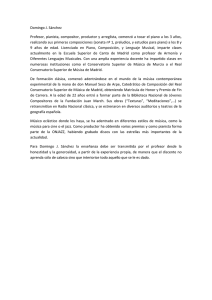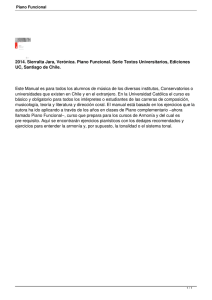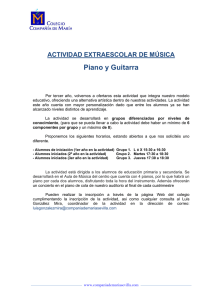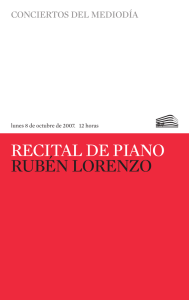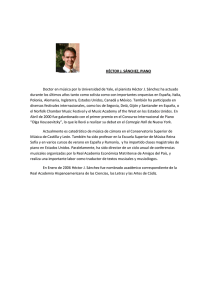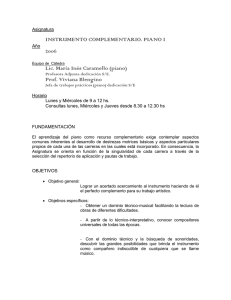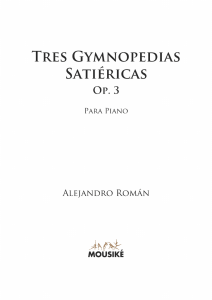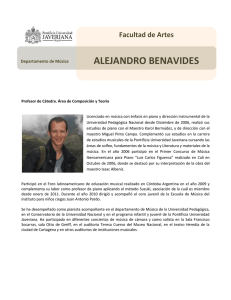Tres Preludios Nocturnos, Op. 2 (portada LULU
Anuncio
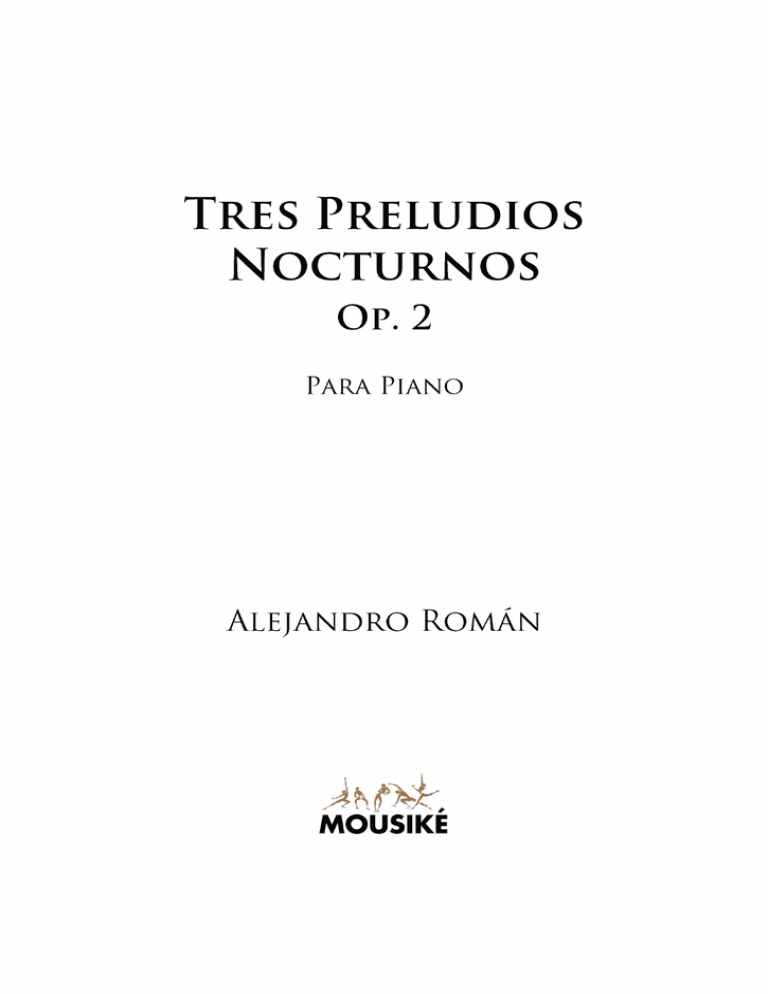
Alejandro Román
Tres Preludios
Nocturnos
Op. 2
Para Piano
Tres Preludios Nocturnos, Op. 2 Duration: 12´20” First performance: Auditorio Manuel de Falla del Real Conservatorio Superior de Música de Madrid, 21 de Octubre de 2013, Borislava Taneva (piano) Dedicated to Ana Bogani, Agustina Palaviccini y Miguel Zanetti SGAE -­‐ Madrid 1997, 2004 Primera Edición, Diciembre de 2015 Edición y Texto © Mousiké C/ Picasso 7 28223 Pozuelo de Alarcón Madrid – (Spain) © Alejandro Román, 2015 Todos los derechos reservados www.alejandroroman.com Se prohíbe la reproducción total o parcial de esta obra – incluido el diseño tipográfico y de portada -­‐ , sea cual fuere el medio, electrónico o mecánico, sin el consentimiento del autor All rights reserved for all countries in the world Alejandro Román
Alejandro Román nace en Madrid en 1971. Compositor y pianista, es considerado por la crítica como uno de los más significativos compositores de su generación. Estudió composición con Antón García Abril, Valentín Ruiz y Zulema de la Cruz en el Real Conservatorio Superior de Música de Madrid. También estudió piano de Jazz con Tony Heimer, Jorge Villaescusa y Ricard Miralles, armonía, composición y arreglos y música de cine con Claudio Gabis, Eva Gancedo y Miguel Blanco. Ha realizado cursos de especialización con Giancarlo Simonacci, Carmelo Bernaola, Adolfo Núñez, Emiliano del Cerro y Jean Claude Risset entre otros, asistiendo a diversos encuentros con compositores como Cristóbal Halffter, Leonardo Balada, Joan Guinjoan, Jesús Villa Rojo, Krzysztof Penderecki o Philip Glass. En su catálogo figuran más de sesenta de obras para piano, canto, arpa, guitarra, orquesta, cámara, electroacústica, y también es compositor de temas modernos (jazz, pop) y música para cine, teatro y danza, habiendo escrito la banda sonora de una veintena de cortometrajes y cinco largometrajes. Ha sido galardonado con diversos premios nacionales a la creación musical: Premio de la I Tribuna de Jóvenes Compositores de la Fundación Sax-­‐Ensemble por Argos, Premio “Juan Crisóstomo Arriaga” por Ménades, en el “XVI Premio SGAE Jóvenes Compositores", 2ª Premio “Ángel Iglesias” por Dos Estudios Extraños, en el “II Concurso de Composición para Guitarra “Ciudad de Badajoz”, Premio a la Mejor Banda Sonora Original por Niño Vudú en el "IX Festival de Cine Ciudad de Zaragoza". En 2015 ha recibido el “Premio Cultura Viva” en la categoría de Música por su contribución como intérprete, compositor, investigador y pedagogo. Entre sus obras más representativas destacan “Ménades, op. 28”, para orquesta de cámara, “Argos, op. 26”, para quinteto de saxofones, dos percusionistas y piano, o las obras orquestales “Abriliana, op. 21” y “Acuarelas de Irlanda, op. 42”, aunque son sobre todo destacables sus obras camerísticas, como “Homenaje a Bartok, op. 10”, “Cuarteto de Cuerda, op. 12”, o “Diégesis, op. 52”, y especialmente las compuestas para arpa: “Ludus Ludovico, op. 30”, para flauta, cuarteto de cuerda y arpa, “Sonata, op. 9”, para flauta, violoncello y arpa, “Levedad del Amor, op. 37”, para flauta, violoncello y arpa o “Khitara y Syrinx, op. 35”, para flauta y arpa. También son de reseñar sus obras para piano, especialmente “Gaiena, diez paisajes jienenses, Op. 47”, obra encargo para la 56ª edición del Concurso Internacional de Piano “Premio Jaén”. Sus obras están editadas en varios CD´s. Es Doctor en Filosofía por la UNED, con la tesis doctoral “Análisis Musivisual, una aproximación metodológica al estudio de la música cinematográfica”. Como docente ha sido profesor de la Escuela de Música Creativa de Madrid (EMC), y profesor de Fundamentos de Composición en los Conservatorios de El Escorial y Alcalá de Henares (Madrid). En la actualidad es profesor de la Universidad Alfonso X el Sabio y del Real Conservatorio Superior de Música de Madrid, donde desde 2003 desarrolla su labor docente e investigadora como Profesor de “Composición para Medios Audiovisuales” en el Aula “C.I.N.E.M.A.” (Composición e Investigación en los Medios Audiovisuales). Es autor de varios libros, entre ellos “El Lenguaje Musivisual, semiótica y estética de la música cinematográfica”. El interés creativo de Alejandro Román se basa en la búsqueda de una música personal de cierto eclecticismo a partir de cualquier técnica, estética o inspiración que mantenga una importante conexión con nuestro mundo contemporáneo. www.alejandroroman.com Alejandro Román
Alejandro Román was born in Madrid (Spain) in 1971. Composer and pianist, is considered by critics as one of the most significant composers of his generation. He studied composition with Antón Garcia Abril, Valentín Ruiz and Zulema de la Cruz at the Royal Conservatory of Music in Madrid. He also studied Jazz piano with Tony Heimer, Jorge Villaescusa and Ricard Miralles, harmony, composition and arranging, and film music with Claudio Gabis, Eva Gancedo and Miguel Blanco. He has specialized courses with Giancarlo Simonacci, Bernaola, Adolfo Nuñez, Emiliano del Cerro and Jean Claude Risset among others, attending various meetings with composers Cristóbal Halffter, Leonardo Balada, Joan Guinjoan, Jesus Villa Rojo, Krzysztof Penderecki and Philip Glass. His catalog contains more than sixty works for piano, voice, harp, guitar, orchestra, chamber, electroacoustic, and is also a composer of modern themes (jazz, pop) and music for film, theater and dance, having written the soundtrack twenty-­‐five short films. He has received several awards for music creation: Award for Young Composers Tribune Foundation Sax-­‐Ensemble, Prize "Juan Crisostomo Arriaga" in the "XVI Prize SGAE Young Composers", 2nd Award "Ángel Iglesias" in "II Guitar Composition Competition "Ciudad de Badajoz", Award for Best Original Score in "IX Film Festival Ciudad de Zaragoza". In 2015 he received the "Living Culture Award" in the category of Music for his contribution as a performer, composer, researcher and educator. Among his most representative works include "Maenads, op. 28", for chamber orchestra, "Argos, op. 26", for quintet of saxophones, two percussionists and piano, or orchestral works "Abriliana, op. 21" and "Watercolors of Ireland, op. 42", but are especially noteworthy their chamber works, such as "Homage to Bartok, op. 10", "String Quartet, op. 12", or "Diégesis, op. 52", and the works especially composed for the harp, "Ludus Ludovico, op. 30", for flute, harp and string quartet, "Sonata, Op. 9" for flute, cello and harp, "Lightness of Love, op. 37", for flute, cello and harp or "Khitara and Syrinx, op. 35" for flute and harp. They are also review his piano works, especially "Gaiena, ten jienenses landscapes, Op. 47," a work commissioned for the 56th edition of the International "Premio Jaén" Piano Competition. His works are published in several CDs. He holds a PhD of the Department of Philosophy Aesthetics of UNED, with his doctoral thesis with the title "Analysis Musivisual, a methodological approach to the study of film music". As a teacher he has been professor of Escuela de Música Creativa of Madrid (EMC), and Professor of Fundamentals of Composition at the Conservatory of El Escorial and Alcalá de Henares. Since 2003 developing teaching and research as Professor of "Composition for Film and Audiovisual Media" at the Classroom "CINEMA" (Composition and Research in Audiovisual Media) of the Royal Conservatory of Music in Madrid. He is the author of several books, including "The Language Musivisual, semiotics and aesthetics of film music". For Alejandro Román, the creative interest is based on finding a certain personal music from eclecticism, from any technical, aesthetic or inspiration, to maintain a strong connection with our contemporary world. www.alejandroroman.com
Tres Preludios Nocturnos
Para Piano
Estas tres piezas de juventud fueron compuestas del año 1997 al 2000 de forma individual. En el 2004 se integraron como un único opus en este tríptico de preludios que evocan la noche. El primero de ellos, “Orillas del Manzanares”, se inspiró en el cuadro homónimo del pintor Aureliano de Beruete (Madrid, 1845-­‐1912), uno de los paisajistas más destacados de la pintura española. La música evoca los colores y el curso breve y divagante del río madrileño. El óleo, en el que Madrid puede verse al fondo con algunos de sus edificios más emblemáticos, entre ellos San Francisco el Grande, data de 1878 y se conserva en el Museo del Prado. “Orillas del Manzanares”, óleo de Aureliano de Beruete “Nocturno de Luz” se originó como tema principal del film “Luz de Inocencia” (2000), de Isidro Carbajal, y evoca sonoridades debussyanas como homenaje a su “Claro de Luna”. El preludio final titulado “Zarabanda”, es una pieza escrita sin compás en aras de una mayor libertad expresiva del intérprete. La sarabanda era una danza lenta española en tres por cuatro que surgió en el Renacimiento y que posteriormente se integró en la “suite barroca”. Aquí la música evoca la frescura y la elegancia, como también los momentos mágicos de baile flamenco. Las tres piezas constituyen un homenaje a los preludios para piano de Claude Debussy. Las piezas están dedicadas a mis profesores de piano, Ana Bogani, Agustina Palaviccini y Miguel Zanetti. Three Preludes Nocturnes
For Piano
These three pieces of youth were composed from 1997 to 2000 individually. In 2004 they were integrated as a single opus of preludes in this triptych evoking night. The first, "Shores of Manzanares" was inspired by the eponymous painting by Aureliano de Beruete (Madrid, 1845-­‐1912), one of the highlights of the Spanish landscape painting. The music evokes the colors and the short course and the Madrid meandering river. The painting shows the background of Madrid with some of its most emblematic buildings, including San Francisco el Grande. It dates from 1878 and is preserved in the Museo del Prado. "Shores of the Manzanares", Aureliano de Beruete oil "Night of Light" originated as the main theme of the film "Light of Innocence" (2000), from Isidro Carbajal, evokes debussyan sounds, like a tribute to his "Moonlight". The final prelude entitled "Sarabande" is written without measure in the interests of greater expressive freedom from the interpreter. The Spanish sarabande was a slow dance in three-­‐four time that emerged in the Renaissance and later joined the "baroque suite". This music evokes the freshness and elegance, as well as the magical moments of flamenco dance. The three pieces are a tribute to the preludes for piano by Claude Debussy. The pieces are dedicated to my piano teachers, Ana Bogani, Agustina Palaviccini and Miguel Zanetti. Tres Preludios
Nocturnos
Para Piano
aAnaBogani
I. Orillas del Manzanares
Alejandro Román
{
bœ
bœ
nw
nw
œ
nœ
nœ
Œ
‰. œr œ .
4
œœ.. ˙
nnœœœ 4 ###w
w
œœœ
w
bœ 4
bœ 4
∏∏∏∏∏∏∏∏∏∏∏∏∏∏∏∏
? #### 46
Œ ‰. œr ˙
œœ
###w
w
w
∏∏∏∏∏∏∏∏∏∏∏∏∏∏∏∏
p
nnnœœœ
∏∏∏∏∏∏∏∏∏∏∏∏∏∏∏∏
#### 6
& 4
∏∏∏∏∏∏∏∏∏∏∏∏∏∏∏∏
Muy Calmo q = 70 - 75
nw
nw
4
? #### nœ
nœ
{
∏∏∏∏∏∏∏∏∏∏∏∏∏∏∏∏∏∏
#### œ nœ #œ
6
&
nnœœ ##œœ œœ 4 ##˙˙
œ
w
bœ n˙
bœ n˙
6
4 n nw
w
n
w
œ
œ 4œ œ
œ
‰
˙˙˙ œœœ œJ 4 œœ œœ
œ
œœ œœ œ
4 œ
n
œ
nn œœ ‰ J 4
˙.
#˙˙..
œœ 4 ˙˙˙...
œœ 4 ˙.
#w
œ
œ
œ
œ
œ
œ
#
œ œ #nww
? ## # 46
w
w
4 #w
w
4 Ów
7
∏∏∏∏∏∏∏∏∏∏∏∏∏∏∏∏∏∏∏
#### 6 œ œ œ œœ
& 4 œœ œœ œœ œ
{
œ œœ œœœ..
œœ œ .
œ 6
œœ 4
J
œœ œœ œœ..
œœ
J 46
nœ œj
‰ œj œ œ
j
œ
˙ œ œ
nb˙˙
˙˙
Ó
˙
˙
10
∏∏∏∏∏∏∏∏∏∏∏∏∏∏∏∏
{
∏∏∏∏∏∏∏∏∏∏∏∏∏∏∏∏
w
j
####
œ
2
4
‰. R
&
œ œ œ œjnœ œ 4 œ œ œ 4 Ó.
˙ œ
˙ œ
j˙
˙˙˙
œ
b
˙
˙˙
.
˙
˙
#
œ
n˙
2 ˙˙
4 œw.
? #### ˙˙˙
w
4 ˙
4 w
w
w
w
© Alejandro Román 1.997, SGAE
œ œ
- Tres Preludios Nocturnos, Op. 2 14
accel.
rit.
Andando q = 90 - 95
œj œ.
14
####
&
j
œ œ.
œ.
? ####
{
œ œ œ˙œ
œ˙
œ œ ‰ œ œ. œ
J
J
œ œœ
œ œ˙œ
œ
œ˙
œ˙
œ˙
œ œ.
J
œ
j .
j
j
œ
œ
œ œ.
œ
œ 3
œ
œ
œ
œ
4
œ˙
œ˙
3
4
œœ œœ
#œ
œœ n œœ œœ œ œ œ œ œ œ œ
#
œ nœ œ nœ 4 #œ œ #œ nœ œœ œ nœ œ#œ œ
# 3œ
œ
œ œ œ œ nœœ œ œ œ œ œ nœ
4
& # # 4 œœ
≈
#œ
œ œ bœ œ
4
? #### 43
4
18
{
20
? #### nw
nw
w
{
œ nœ #œ
w
w œ œ œ œœ
nw
nw
w
∏∏∏∏∏∏∏∏∏∏∏∏∏∏∏∏
∏∏∏∏∏∏∏∏∏∏∏∏∏∏∏
∏∏∏∏∏∏∏∏∏∏∏∏∏∏∏∏
####
œ nœ #œ
&
w
w œ œ œ œœ
œ œ
œ œœ
n
œ
#
œ
w
w œ
cresc.
w
nw
w
Lento
{
œ
œw œ œ œ nœ nœ bbb
nw nœ
œ
œœ
p subito
w
œœœœ
w
n
œ
J
bbb w
Œ ‰
w
w
nw
26
œœœœœ
œœ œœ
œ
w
w œ œ œ œ
w
w
w
Œ
œ
œ œ
œ
nœ œ œ œ
‰ J
∏∏∏∏∏∏∏∏∏∏∏∏∏∏∏∏∏
œœœœœ
∏∏∏∏∏∏∏∏∏∏∏∏∏∏∏∏∏
{
∏∏∏∏∏∏∏∏∏∏∏∏∏
∏∏∏∏∏∏∏∏∏∏∏∏∏∏
∏∏∏∏∏∏∏∏∏∏∏∏∏∏
∏∏∏∏∏∏∏∏∏∏∏∏∏∏∏∏∏∏∏
œœ œœ
œ
b
œ
& b b œ œœ
Œ œ
w œ
? bb w
b w
œ
w
wœ œ œ œ
∏∏∏∏∏∏∏∏∏∏∏∏∏∏∏∏∏
? ####
∏∏∏∏∏∏∏∏∏∏∏∏∏∏∏∏
####
&
∏∏∏∏∏∏∏∏∏∏∏∏∏∏∏∏∏
23
œ
w
wœ œ œ œ
w
w
w
Œ
œ
œœ
œ
nœ œ œ œ
‰ J
œ
w
w œ œ œ œ
w
w
w
Œ
œ
œ œ
œ
nœ œ œ œ
‰ J
- Tres Preludios Nocturnos, Op. 2 15
”
“
œ œ œ
poco rit.
29
{
∏∏∏∏∏∏∏∏∏∏∏∏∏∏∏∏
œœ œœ œ œ
œ
b
œ œ
& b b œ œœ œœœ œœœœ
Œ œ
w
œ œœ œœ
w
? bb
b w
œœ
œœ
œœ
œœ
œœ
œœ
œœ
œœ
3
4œ œ œ
4
4
œœ
œœ
œœ
œœ
3 œœ
4œ
4
4
œ
œ
Poco piú mosso
<“>
32
œ œ œ œn œ œ œ œb œ œ ˙˙
œœ
bb 4 œ œ œ œ
2
b
4˙
& 4
{
? bb 44
b œ
b œœœœ
œ
œ
œ
œ #œ
œœ œ
4 œœ œ œ œ œ œ nœ œ œ œ nœ œ 2
4
4
œ#œ
2 œ.. 4 œ #œ œ œ œ #nœœœœ
4 œ j4 œ
œ
2
4
35
b 2
& b b 4 b˙˙˙
{
4
4
? bb 42 bœ
b œ œ
œœ œ
œœ œ œ œ œ œ
œn œ œ œ# œ œ œ œ
j
nnœœw.. œ ˙˙˙
w
w
4 œ #œ œ œ
4
œ nœ nœ
œ nœ
˙˙˙
w
w
w
œ œ
Andando
39
b
&b b
j
œ œ.
œ ˙..
J ˙˙.
œ.
? bb œ œ œ
œ˙
b œ˙
{
œ
œ œ œ.
œ œ œ˙œ
œ˙
œ
œ
œ
œ
œ˙
œ
œ˙
∏∏∏∏∏∏∏∏∏∏∏∏∏∏∏∏∏
∏∏∏∏∏∏∏∏∏∏∏∏∏∏∏∏∏
{
j œ. œœj 2
œ
4
œ
œ
œ
œ
w
œ œ
œ
œ
w
œ
œ
œ
œ
œ
œ
b
2
4
œ
œ
œ
b
œ
b
4
& 4
œ œ
œJ œ œœ œ
Œ
‰
w
w
4 w
? b 42 œ
4
bb
43
œj œ.
j
œ œ.
œ
œ˙
œ
œ˙
2
4
œ
w
wœ œ œ œ
œ
œ
œ
œJ œ œœ œ
Œ dim. ‰
w
w
w
- Tres Preludios Nocturnos, Op. 2 16
{
∏∏∏∏∏∏∏∏∏∏∏∏∏∏∏∏∏
œ
w
w œ œ œ œ
œœ
b
œ
b
& b
œ œ œœœ
œ
œ
œ
œ
Œ
J
‰
w
w
? bb w
b
46
œœ
œœ
œœ
œœ
œœ
œœ
œœ
œœ
œœ
œœ
œœ
œœ
œœ
œœ
œœ
œœ
œœ œœ œœ œœ œœ œ œœ œœ
œ
48
b œ
& b b ##nœœœ
œœ
œœ
œœœ œœ
œ œ
œœ
œœ
œœœ œœ œœœ
œ œ œ
œ
nnœœ
3
œœœ œœ #œœ œ nœ œ
4
œœ
œ
rit.
w
? bb bb∫w
w
b
˙˙..
{
3
4
œ
Iº Tempo q = 70 - 75
50
b 3
&b b 4
∏∏∏∏∏∏∏∏∏
œœœ
œ
œœœ
3
? bb 4 œœ
b
œœ
{
œœœ
œœ
œœœ
œœ
œœ
œ
œœ
œ
œœ œœœœ œ
œœœ œ bbœœœ
œ
nnœœœœ
œœœ 42 bœœœœ nœœœ œœ œ 44 nœœœ
œ nœœ œœœ b œœ nœœ
œœ
œ
bœ
2 bœœ œœ œœ bœœ 4 œœ
4
œ œ bœ 4 œ
53
bb nœœ
b
& nœœœ
œœ 42 œœ œœ œ nœœ 44 ˙˙ ...
œœœ œœœ œœœ bbœœ nnœœœ ˙˙˙..
œ
œœœ
œœ
œœœ
œœ
œœœœœ
bœœœœœ œbœœœ nœœ
œnœœœ
œ œ
œœ œœ œœ œœ bbœœœ œœ
œ
œ œ
“”
r
œ
œ.. œ
#### 4
2
4 #˙˙
4
n˙
p
? b œœœ œœ œœ bbœœ œœœ œœœ 42 œœ œœœ bbœœ œœœ 44 ˙˙˙...
bb
œ
œ œ bœ
bœ
{
Œ
#### 44
2
4
<“>
57
œ
œ
#### 4 œ œ œ œ nœ œ œ œ œ nœ œ œ 6
& 4
œ œ œ nœ
6
6
bbb
f
6
# œœ
#
? ## # 44 œ
{
n œœœ
œœ
œ
œœ
#œœœ œ œ œ nœ bb
b
- Tres Preludios Nocturnos, Op. 2 17
“”
6
œ œ œ œ
œ6 œ œ œ
n
œ
œ
œ
œ œ œ œ œ
n
œ
œ
6
58
b
&b b
6
n œœ
œ
# œœ
œ
œ œ nœ
? bb œ nœ œ œ
œœ
b nœ
nœ
{
Lento
<“>
p subito
w
? bb w
b w
Œ
{
œ
œ œ
œ
nœ œ œ œ
‰ J
∏∏∏∏∏∏∏∏∏∏∏∏∏∏∏∏∏
∏∏∏∏∏∏∏∏∏∏∏∏∏∏∏∏∏
œw
œ
b
w
œ
œ œ
b
& b
59
œ
w
w œ œ œ œ
œ
œ œ
œ
nœ œ œ œ
‰ J
w
w
w
Œ
2
4
2
4
Iº Tempo
“”
œ..
#
bb 2 ˙˙
b
& 4
61
r
œ
œœ œœ œœ œœ
œ nœ œ nœ œ
#### 4
4
6
6
œœœœ
bbb
nœ
6
f
6
# ˙˙
n
? bb 42 ˙
b
{
# œœ
#
## # 44 œ
n œœœ
œœ
œ
œœ
#œœœ œ œ œ nœ
bbb
Lento
“”
6
{
∏∏∏∏∏∏∏∏∏∏∏∏∏∏∏∏∏
œ
œ œ œ œ œ 6œ œ œ œ w
n
œ
œ
bb
wœ œ œ œ
œœ
œ
œ
œ
b
n
œ
&
œ
œ
œ
œ
6
p subito
6
n œœ
#
œ
w
œ
œœ
œœ
œ œ œ œ
w
n
œ
? b œ nœ œ œ nœœœ
w
J
b b nœ
Œ ‰
nœ
63
- Tres Preludios Nocturnos, Op. 2 18
<“>
{
œ
w
wœ œ œ œ
œ
œ
œ
w
œœœœ
w
n
œ
w
J
Œ ‰
∏∏∏∏∏∏∏∏∏∏∏∏∏∏∏∏
œ
w
œ
w
n
œ
œ
œ
? bb w
b Œ ‰ J
∏∏∏∏∏∏∏∏∏∏∏∏∏∏∏∏∏∏∏
∏∏∏∏∏∏∏∏∏∏∏∏∏∏∏∏∏∏∏
œ
bb w
œœœœ
w
œ
b
&
œ
œ
65
œœœœ
œ
œœœœ
œœœœœ
œœœœœ
œœ
œœ
Œ œ
œ
w
w œ œœ œ
w
œœ
œœ
œœ
œœ
œœ
œœ
œœ œœ œ œ
œ œ
allarg.
Iº Tempo
“”
Œ ‰. œr ˙
œœ
w
w
w
‰. œr .
˙.
œ
.
œ
œ
œ
b
œ.
w
&b b w
œ
w
œœ
∏∏∏∏∏∏∏∏∏∏∏∏∏∏∏∏
? bb n#w
w
b
# œ œœœ à
#
œ
#
œ
œ
#˙˙..
##nœœœ
Œ
˙˙..
œœ
n
n ˙.
œ
Œ
∏∏∏∏∏∏∏∏∏∏∏∏∏∏∏∏
{
∏∏∏∏∏∏∏∏∏∏∏∏∏∏∏∏
b œw
&b b # w
wœ œ
#œ# œ
œ œ#œ
∏∏∏∏∏∏
69
˙.
##nœœœ
bbbw
w
w
˙˙..
˙.
œœœ œœ œœœ
œ
œ
œ œ œ
œœ œ œ
œ
œ
œ
œœ œ
73
nœœœ
dim.
{
? b bw
b bb w
bw
?
˙˙..
˙.
Œ
&
œœœ
œ
œœœ
œ
˙˙˙
˙
œœ œœ œœœ
œ
œ
b
œ œ œ œ
& b b œœ œ œ
76
œ
? bb œœ
b
{
œœ
œ
˙˙
˙
œ œ
∏∏∏∏∏∏∏∏∏∏∏∏∏∏∏∏∏∏∏∏∏
“”
w
w
w
w
w
w
w
w
w
w
U
w
w
w
w
pp
w
w
w
w
w
w
U
w
4'59"
aAgustinaPalaviccini
19
II. Luz de Luna
Alejandro Román
Lento y expresivo q = 69
### 3
& 4 œ
œ œ
œ œ
œ œ œ˙˙..
œ ˙˙.
n˙.
˙˙.
˙.
œ œ œ˙˙..
œ
pp
˙.
? ### 43 Œ
{
˙.
˙.
˙.
5
3
### ˙
&
n˙˙..
œœ
œ œ œ
3
3
3
œœœœœœ œœœœœœ œœ
œ
œœœœœœœœœ
3
3
3
3
3
˙˙..
˙.
? ### n˙.
{
˙˙..
˙.
˙˙..
˙.
9
###
&
œœ..
j
œœ n œœ œœ
# œœ..
? ### bn˙˙˙...
˙.
˙.
{
j
œœ œœ œœ œœ œœ œœ œœ œœ œ œœ œœ œ œ œ
œ
œ œ œ
˙.
˙.
˙.
˙.
4
4
4
4
13
œ œ
˙
œ
3
œ
˙˙.
˙
œ
˙
œ
j
.
.
œ œ
‰ œ 4 ˙.
˙.
n˙.
˙˙..
Œ ˙˙
Œ ˙˙
Œ ˙˙
œ
œ
˙
˙
˙
˙
œ
˙.
#
.
.
3
? ## 44
4
œ œ œ
œw
### 4
& 4
{
17
Œ ˙
? ### ˙. ˙
{
j
œ
œ.
œ œ
œ
œ
˙˙.
.
Œ ˙
Œ ˙˙
n˙. ˙
˙.
© Alejandro Román 2.004, SGAE
∏∏∏∏∏∏∏∏∏∏∏∏
3
### œ œ œ œ œ ˙
& ˙˙..
n˙˙..
˙˙.
˙˙...
˙˙.
j
4
œ
.
œ
œ
œ
œ
˙.
œ 4
˙˙..
˙.
4
4
- Tres Preludios Nocturnos, Op. 2 20
poco rall.
Poco più mosso q = 72
œ
nœ œ œ œ
22
### 4
œœœ
œ
n
œ
& 4 œw œ œ œ œ
nœ
nnn ˙.
#w
w
œ
w
#w
w
mf
w
? ### 44 bnw
w
{
œœ œ
#œ œ œ œ
#
œ
œ
œ œ
œ œ œwœ
œw
nnn
25
œ
˙.
& nbw
w
w
{
?
œ
˙.
w
w
w
œ
˙.
w
w
˙.
w
w
œ
bœ œ
œœœœœ
œ
nœ œbœ œ œ œ
œœœœœ
œ
œ
n
œ
œ
œ œw
œ
œ œwœ œ
œw
œw
29
œ
w
#w
w
.
& ˙w
w
{
?
œœ
œwœ
œœœ
œ
w
#w
w
.
n˙w
w
œ
œ œ#œ
#œ œ œ œ
œ#œ œ œ œ œ
œ
œ
œ
œ
œ
œ
œ
œ
œw
œw
œw
33
œ
& #˙w.
w
{
?
˙w
w
œ
œwœ
#œ œ œ œ œ
œnœ
œ
œw
j œ œ œ œ˙˙ œ ˙. ˙˙
œ
œœœ
œ
œ œ ˙.
w
w
œœ
œœœ
œ
œ
œ
œ
œ
œ œw œ
œ
œwœ
37
### ˙.
w
w
œ
˙.
& #w
w
œ œ œw
w
œ œ
œ
˙w.
nw
œœ
p
{
˙
?
œœœ
œw
œ#œ œ#œ œ œ œ
### œ œ œ œ œ œ œ œ œ œ œ œ œ œ
œw
œw
œw
- Tres Preludios Nocturnos, Op. 2 21
41
3
3
3
3
œ œ.
### œ
& w
w
œj ˙.
w
nw
œ œ 43 œ˙˙.
.
œœ
œœœœœœ œ œ œœœœ œœ
œ
3
3
? ###
{
˙
œ˙
œ˙.
œœœœœ œ
nœ œ œ 43 œ ˙˙
œ
œ
œ nœw œ
œ
œw
œ˙.
45
3
###
&
j
œœ n œœ œœ # œœ..
œ œ œ œ œ œ œ œ œ œœ..
? ###
{
3
3
Œ b˙˙˙
n ˙.
˙
œ ˙
œ˙.
j
œœ œœ œœ œœ œœ œœ œœ œœ œ
œ
Œ ˙˙
˙.
˙
Œ
˙.
Meno mosso q = 69
49
###
&
‰ œj 43 ˙˙˙.. œ œ
œœ œœ œœ œ œœ ˙˙..
œ
p
Œ ˙˙
œ
œ
œ
4
3 ˙. ˙
? ### Œ ˙
œ
œ
4 œ
4
˙.
œw
4
4
{
œ˙. œ œ œ ˙˙
˙.
n˙..
Œ ˙˙
˙. ˙
œœ
Œ ˙˙
˙.
54
Œ ˙˙
#
? ## ˙.
{
Œ ˙˙
n˙.
∏∏∏∏∏
œœj œœ œ
J œ
œ œœ œ.
œœ.
.
Œ ˙˙
˙.
∏∏∏∏∏∏∏∏∏∏∏∏∏∏∏
3
### œ œ œœ œœ œœ ˙
& ˙˙..
n˙˙
˙˙
j
4
œ
.
œ
œ
œœ œœ ˙
œ œœ 4
˙˙...
˙˙.
˙˙..
˙.
4
4
rall.
59
### 4
œœ
œ
n
œ
& 4 œw œ œ œ œ
nœ
œœœ
n
œ
œ
œ
˙
3
4
4 ˙˙
œ 4˙
˙˙
˙
U
Œ
˙.
˙˙..
pp
w
? ### 44 bnw
w
{
3 ˙˙˙
4
Π44 w
w
U
Œ
œ. j
œ. œ
>œ
3'09"
aMiguelZanetti
22
III. Zarabanda
Alejandro Román
¿
Maestoso q = 90
& œ. œ œ. œ ˙
˙
˙
bœœ œœ ˙
b˙
#˙˙
œ. œ œ. œ ˙˙
˙
˙
˙
˙
bœœ œœ ˙
b˙
#˙˙
p
? bœ
œ
{
bœ
¿
bœ .
.
& bœœ.. œ œœ... œ bœœœ.. œ ˙˙˙
œ
f
œ
Più mosso
œœ. œ œ
œœ
œ..
bœ . œ œ bœ . œ œ
œœ bœœ..
œœ
bœœ..
p accel. e cresc.
œ
? œœ
bœœ
bœ
{
bœœœ
˙˙
˙
bbbœœœ
œœ
œ
mf
œœ
œ
bœœ
bœ
œœ
œ
bœœ
bœ
Tempo primo
rit.
¿
&
œœ.. œ ˙
œ. b˙˙
˙˙
˙
œœ. œ œ. œ ˙
b œ œœ b ˙˙
‰. œr
˙˙
#˙
œ. bœ œ. b œ œ. œ b œ. œ
p
? bœœ
œ
{
œœ
œ
w
w
w
œœ b˙
œ bb ˙˙
˙˙
˙
œ
Œ ‰. R œ.bœ œ. bœ œ. œ bœ. œ #˙˙
&
#˙
{
? ˙
˙
&
˙
bbœœ
bœ
œœ
œ
œœ bœ
œ bb œœ
˙˙
˙
Œ
bbbœœœ
œœ
œ
œœ bœ
œ bb œœ
bœ
œœ œ œ œ œ œ œœ œbœ œ. œ b˙
œ. ˙
œ
bœœ
?œ
bœœœ ˙˙
œ
b
œ
˙
œœ
œ
© Alejandro Román 1.997, SGAE
- Tres Preludios Nocturnos, Op. 2 23
bœœ
bœ
{
? œœ œ œ bœ œ œ œ
œ
∏∏∏∏∏∏∏∏∏∏∏∏∏∏∏∏∏∏∏
œœ
œ
& œœ
U
n˙˙..
bœœœ
n ˙˙..
U
œ bœ œ. œ ˙˙˙...
Œ
œ. œ œ. œ ˙
p
bœ
bœœ
œ
œœ
Œ
¿
¿
& ˙
˙
œ. œ œ. œ ˙˙
˙
˙
bœœ. œ. bœœ.. œ œ œ
bœ.. œ œœ.. œ œ. œœ œœ
˙
˙
f
{
? b˙˙
bœ
#˙˙
œ
bœœ œœ ˙
b˙
œœ
œ
#˙˙
bœœ
bœ
bœœœ
œœ œœ
œ œ
rit.
¿
œœ. œ œ bœ. œ bœ. œ œ.
& œ.. œœ bœœ.. œ œœ bœœ.. œ œœ œœ.. œb˙˙
˙
p accel. e cresc.
mf
b
œ
œ œ
œ
? bbœœ œœ œœ bbœœœ œœ bbœœœ bœœ ˙
œ ˙
˙
{
A tempo
˙˙
˙
‰
˙˙
˙
Œ.
œ œbœ œ œœ œ œbœ œ œœ œ œbœ œ
œœ..
œ.
œœ..
œ.
œ #œ œbœ nœ
b
œ
œ
œ
œ
œ
œ
œ
œ
œ
œœ
& œ œ bœ œ œ bœ œœ œ œbœ œ œ œbœ œ œ œbœ œ œ œbœ
œ. œ.
8
{
? bœ.. bœ..
bb œœ. bb œœ.
œœ..
œ.
œœ..
œ.
œœ..
œ.
bbbœœœ...
bbbœœœ...
œœ..
œ.
œ œ b œ œ œ œ b œ œ œ œb œ œ
œœ
œœ
œb œ œ œ œ œb œ œ b œ œ œ œ œ b œb œb œ œ
& œœ
#œ
œ
œ
œ
œœ..
b œœ..
œœ..
œœ.. œœ..
b
bœœ..
œ
.
œ.
? bœ .
b
.
.
œ
œ
œ. œ.
bœ .
œ.
{
- Tres Preludios Nocturnos, Op. 2 24
3
3
3
3
3
3
œ
& œ œbœ œ œbœœ œbœœ œbœ œ œ œbœœ œbœœ œbœ œ œ œœb‰œœœœœb‰œœœœœbœ œœ
œ
œ
œ
œ œ
œ
œ œ J
J
mf
b œœ
œ
? bbœœœ...
{
b œœ
œ
b œœ
b œœ
œ œœ œ
> œ
>
3
3
b œœ
œ
b œœ
œ œœ
> œ
>
œœ
œ
3
œœ
œ
3
œœ
bœ
>œ b œœ
>
3
3
œ œ œ œœœœ œœœ œ œ œ œ
œ
œ
œ
œ
œ
œ
œ
œ
œ
œ
œ
bœ bœ œ
bœ bœ
œ
œ
& œœ b‰œ œ œ œœ b‰œ œ œ œœ bœ œœ œ
J
J
b>œœ bb>œœ
œœ
œœ
? œœ
b
œœ
œœ
œœ
bœ bœ
b
œ
b
œ
œ
œ
œ> bœœ œœœ
b
œ
b
œ
œ
œ
œ
b >œ
b >œ b >œ
{
A tempo
rall.
œœ.. œ œ. œ bœ. œ
œ. b œ. œœ.. œ
&
œœ..
œ.
œœ.. œ œœ..
œ.
œ.
b œœ
b
? œœ bœ
œ
bœœœ..
.
œœ.. œ bœœ..
œ. œ œ.
{
œœ
œ
bœœ
bœ
œœ.. œ œ.
œ.
œœ.. œ œœ..
œ. œ
3
œ.. bœ .. œ
bœ ˙
&
˙
3
{
& œ.. bœ
b œ.. œ ˙
˙
&
{
& ˙
œ. œ
œ.
&
3
œ
œ œ bœ œ œ œ. œ. œ
?
œ. œ
œ
œ œ bœ œ œ œ . œ . œ
˙
œ bœ. œ. œ
œ œ bœ œ œ
3
œ œ b œ. œ. œ
œ
b
œ
œ
œ
&
3
3
œ œ œ bœ œ
œ
œbœ
?
œ œ œ bœ œ
œ
œb œ
3
bœ œ œ
œ bœ. œ.œ ˙
bœ œ œ
bœ œ œ œ bœ. œ.œ ˙˙
œ b œ. œ.œ
3
œ. œ. ˙
œ
œ. œ. ˙
œ. œ.œ ˙
œ
U
˙&
U
˙
˙&
- Tres Preludios Nocturnos, Op. 2 25
¿
& œ. œ bœ. œ ˙
˙
˙
b ˙˙
n˙˙
˙
œ. œ bœ. œ ˙
˙
˙
˙
˙
b ˙˙
n˙˙
p
{
?
& bœœ
?
bœœ
&
œœ
bœœ b œœ
œœ
bœœ b œœ
¿
Meno mosso q = 80
b œœ.. œ.
& bœ. œ œœ.. bœ
bœœ.. œ ˙˙
œ. ˙
œ.. bœ œ.. bœ œ bœœœ
œ.. bœ œ.. bœ œ bœœœ
p
f
œœ
? œ
bbbœœœ
{
b œœœ
3
˙˙
˙
3
b œœ
œ
3
b œœ
œ
b œœ
b œœ
œ œœ œ
œ
b œœ
œ
b œœ
œ œœ
œ
3
& œ bœ œ œ bœ œ œ bœ œ œ œ bœ œ œ bœ œ œ bœ œ œ œ bœ œ œ bœ bœ œ bœ œ bœ œ bœ
œ
œ
œ
œ
œ œ
œ
b œœ
b œœ
b œœ
b œœ
b œœ
b œœ
b œœ
b œœ
? b œœ
œ
œ
œ œœ œ
œ œœ œ œœ œ œœ œ œœ
œ
œ
œ
œ
œ
{
3
3
3
& œ bœ œ œ bœ œ œ bœ œ œ œ bœ
œ
œ œ
œ
? b œœ
b œœ
œ
{
œ
œ œ bœ bœ bœ œ bœ œ
bœ œ bœ œ œ œ bœ œ œ œ bœ œœ œ
b œœ
b œœ
b œœ
b œœ
œ œœ œ bœ œ bœ œ œ
œ
bb œœ
œœ
œ>
b >œ
>
>
œœ
œ
œœ
œ
3
3
3
œœ
œ œœ
>œ
3
3
œ
& œ bœ œ œ bœ œ œbœ œ œ œbœ œ œbœbœ œbœ œbœ œ œ bœ bœ œ œ œ bœ œ œ œbœ œœ
œ
œ œ
{
?
œœ
œ
œœ
œ
œœ
œ œœ
>œ
œœ bœ œœ œ œœ œ
œ bb œœ œ œœ œ œœ
>
>
>
bœœ
bœ
bœœ
bœ
bœœ
bœ bœœ
b >œ
- Tres Preludios Nocturnos, Op. 2 26
3
3
3
3
bœ œ3œœœ œ3œœœbœ
bœ œbœ œ œbœ bœ
&
bœœœ œbœ œ œ œbœœœ œbœœœ œbœ œ œ
œ
œ
œ
œ
b œJ ‰ b œJ ‰ b œ œ b œJ ‰ b œJ ‰ b œ œ
> >
?
bbbœœœ bbbœœœ bbbœœœ œœ œœ œ
œœ
œœ
œœ
œœ
œœ
b
œ
œ
œ
œ
bb œœ
bœ
bœ
> > œ
œ
œ
>œ b œœ œ
>œ b œœ
>
>
{
3
3
3
3
œbœœœœbœœœ œbœ œ œ œbœœœœbœœœœbœ œ œ œœ..œœœ..œbbœœ..œœ..œ .
?
œ œœ.œœ..œ bœ.œ .
& œ
œ
œ œ œ
œ
œ œ
œ b œ. œœ.œ
{
? œ
œœ
œœ
œ
? œœ œ œ bœ œ
{
? œ
bœ b œ
>œ b œœ
>
>œ
œœ
>œ
œœ
œœ
œ
œœ
œ
>œ
œœ
bœ
œœbbœœ
œ
œœ bœ
œ bœœ œ œœ
œœ b œ
>œ
b
œ
œ
>œ
œ œ b œœ
b
œ
J ‰ bœœœ
œ œ bœ œ œ œ
J
3
œ bœ œ œœ
œ
œœ
>œ b>œ
œ œ
b œœ bœ
œ bœ
œ œ
œ
> >
&
>œ
œœ
œœ bœ
œ b œœ
‰ Ó
3
b>œœ
œ
>œ
œ
œ
j
œœ ‰ j ‰ Ó
œœ
>œ
>œ
3'39"
ALEJANDRO ROMÁN Catálogo de Obras para Piano “Miniaturas, op. 1” (1997) Duración: 11 min. “Tres Preludios Nocturnos, op. 2” (1997-­‐2004) Duración: 12 min. “Tres Gymnopedias Satiéricas, op. 3” (1997) Duración: 6 min. “Orestes, op. 4” (1997) Piano Preparado Duración: 4 min “Sonatina, op. 7” (1999) Duración: 11 min. “Entre Arrecifes, op. 11” (1999) Duración: 4 min. “Black Cage, op. 19” (2002) Piano preparado y electroacústica Duración: 8,5 min “Gaiena, doce paisajes jienenses, op. 47” (2013) Duración: 7 min. “Ewig, op. 58” (2015) Duración: 7 min. “Abriliana, op. 21b” (2015) Duración: 6´5 min. “Catálogo de Elfos y Hadas, op. 36b” (2015) Duración: 12 min. “OidaRadio 2, op. 59” (2015) Duración: 4´5 min. “Bocetos Flamencos, op. 12b” (2016) Duración: 21 min.
